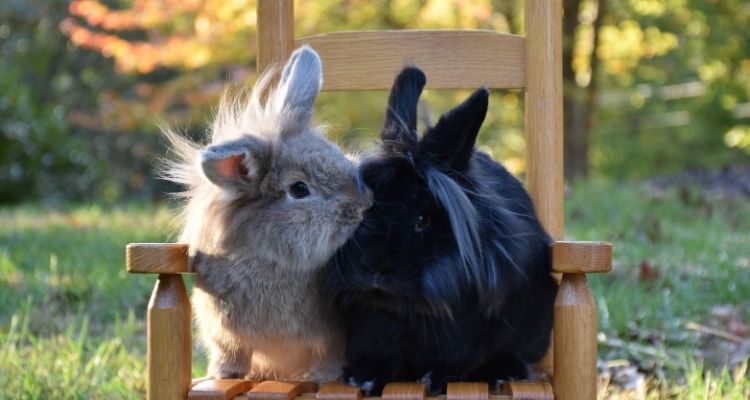Rabbits are delicate animals and rabbit grooming needs to be carried out on a regular basis, with gentle care. The grooming process is also a wonderful way to bond with your rabbit.
Whilst you may have observed your rabbit frequently grooming themselves, it is important to regularly brush your rabbit, trim their nails and check their ears, eyes, feet and genitals.
This guide will highlight all of the essential rabbit grooming basics and will help you learn about grooming your bunny.
Rabbit Molting and Shedding

Rabbits will have 2 to 4 shedding periods during the year. Typically, they will have a rather hefty shedding period twice a year in the spring and fall, when they are losing their winter and summer coats.
They will have a smaller shedding season during the summer and winter.
Every bunny will have their own shedding routine. It will vary based on the breed of rabbit and the climate that you live in.
As your rabbit is shedding you will notice a line proceeding down their back separating the thicker and thinner coats. This is particularly noticeable in rabbits who have a different shade of undercoat, but can also be seen in single color rabbits.
Rabbits will typically begin shedding from their forehead and cheeks then afterwards gradually shed the fur on their backs and downward to their bottom.
Can You Give Rabbits a Bath?
Rabbits do not enjoy being bathed. Bathing generally causes stress in your rabbit and is not recommended. A wet rabbit can also rapidly become hypothermic. We suggest giving your rabbit a dry bath.
If your rabbit is too dirty to clean without bathing, read our full guide on bathing rabbits. This will help to keep your rabbit safe and well if you need to spot bathe them from time to time. Remember that rabbit bath shock can occur and is a potentially fatal condition.
How to Groom a Rabbit – The Basics
Grooming your rabbit’s fur consists of brushing, fur trimming and matted fur removal. General rabbit grooming also includes cleaning the eye area, ears, the underside side and genitals of your rabbit and clipping your rabbits nails.
Rabbits consistently groom themselves, so they will often have some hair ingested within their body. Our role in the grooming process is to restrict their ingestion of fur and also to help keep the fur and skin of the rabbit clean and mat free.
Fur clumping or matting can cause irritation and discomfort on the skin of your pet rabbit. Too much swallowed fur can also cause gastrointestinal issues for your rabbit.
How to Brush Rabbit Fur
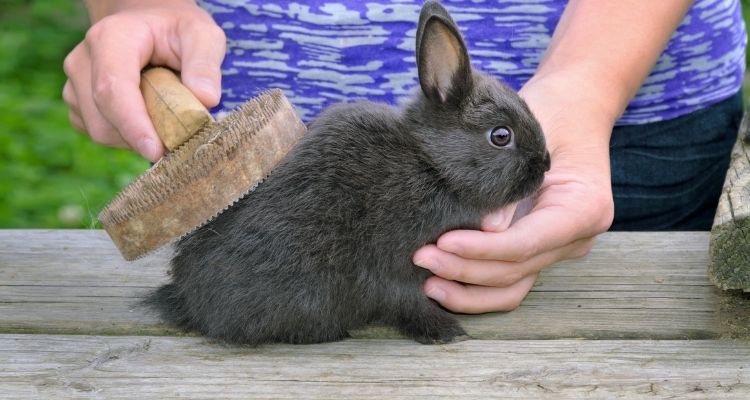
Rabbits need to be brushed at least every three days. Rabbits will shed their fur in different ways. Just like humans, rabbits are unique creatures. Some rabbits will take a couple of weeks or more to loose their old coat of fur, some will shed their coat in a matter of days.
By careful combing of our rabbits during the rabbit grooming process, we assist to reduce ingestion of fur by the rabbit. This is necessary to protect against health problems such as gastrointestinal blockages.
When the rabbit is shedding, more frequent brushing is encouraged. Rabbit skin is quite fragile, so be gentle and use a brush designed for rabbits if possible.
Rabbit grooming is usually a daily ritual if you have an Angora rabbit. Look for matting in their fur, and ensure any hay is not lodged. Pieces of hay can work their way downward towards the rabbits skin, causing irritation.
When grooming your rabbit, always brush in the direction of the fur, using slow gentle strokes.
If your rabbit is sensitive and restless when being brushed, you may need to try out several techniques. Finding what works best for your bunny will help them feel comfortable and safe during the grooming process.
Rabbits have scent glands under the chin, so gently cradling your rabbit here can help them feel secure, especially if they are familiar with your scent.
Long haired rabbits will sometimes develop matting in their fur. Before resorting to using scissors to cut these out, try using a wide tooth comb. Rabbit skin is very delicate and can easily be nicked with scissors. If you must, use scissors as a last resort and with care.
Most rabbits enjoy being smoothly pet, so if you find they can’t stand to be brushed regardless of what you do, you can always fall back on using your hands to gently run through the rabbits fur. During this process, gently pluck off unwanted fur and brush them with your finger tips like a soft massage.
This technique is particularly useful during heavy shedding times. You can gently lift out tufts of fur post grooming. Most rabbits tolerate this gentle process well.
Rabbit Ear Cleaning

Keeping the rabbit’s ears clear of dirt or wax is very important. The ears should be regularly checked and any built up wax in the outer ear should be removed.
Lop rabbits commonly have moist areas inside their ears which you must to always keep dry and clean. Damp ears can cause your bunny to experience an ear infection or inflammation, both of which may call for veterinary care.
Helping keep the eyes free from hay or fur will help prevent soreness and possible irritation of your rabbit’s eyes. We use dampened cotton balls and delicately clean the area surrounding the eye. If your rabbit is inclined to have a large amount of fur around their eyes, you can use a mascara brush or a small flea comb to smooth back the fur out of the eye.
Ear wax from the outer ear can be removed with a cotton swab or a q-tip. Be careful not to push on wax in the canal, and never attempt to reach into the ear canal. Do not poke the q-tip into the ear canal, this could cause damage to your rabbit.
If you find your rabbit has particularly dirty ears, speak to your vet. They may recommend a variet of wax removal products that are safe for your rabbit.
Rabbit Nail Trimming
Rabbits dig burrows in the wild which help to wear down their nails. As much as your bunny might try, the opportunity to dig with a house rabbit is of course, far less.
To accommodate frequent digging, rabbits nails grow quite fast. It is essential to keep your rabbits claws trimmed. Rabbits with nails that are too long are prone to shifting their weight onto their heels. You rabbit will also be more comfortable with trimmed nails.
When brushing your rabbit, check their claws at the same time. Handle their feet and get them used to this. When looking at your bunny on the ground, the nail tips should not touch the floor.
Baby rabbit nails are very sharp. Rather than clipping their nails, we recommend using an emery board to gently file back the tips of their claws.
People are often afraid to clip nails for fear that they will trim incorrectly and cause the rabbit to bleed. This is a genuine concern and can happen.
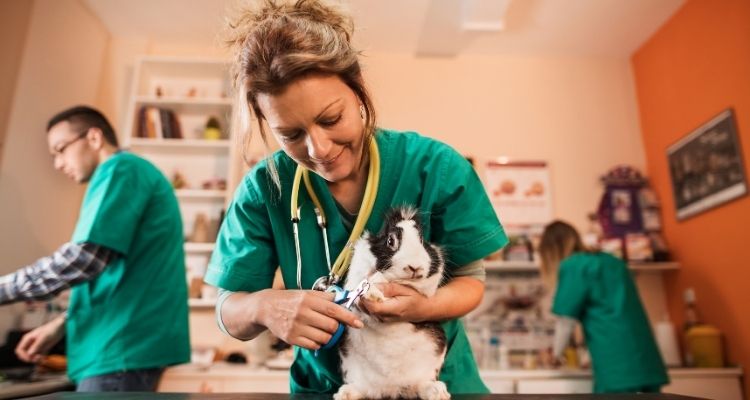
When learning to trim your rabbits nails, we often suggest a cuddle approach, as follows:
- Wrap your bunny in a soft towel or blanket to keep him secure.
- Sit down, or place the rabbit on a table or bench in front of you.
- Cradle the rabbit like a football in your arm or in front of you.
- Bring one foot at a time out of the blanket and trim the nails, keeping all other paws secure.
If your rabbit has light colored nails, the claw clipping process will be slightly easier. Take a close look at your bunnies claws and see if you can see where the blood supply starts. This is called the “quick”.
You want to ensure that you are cutting below the quick. Cut in the direction of the nail on a 45 degree angle.
If your rabbit has darker colored nails, shine a flashlight behind the nails to help you see the quick.
Be careful in trimming nails and always have on hand a styptic powder (available on Amazon here) just in case you accidently cut too close to the quick and cause the claw to bleed.
A professional groomer or veterinarian can assist if you are uncomfortable trimming your rabbit’s claws. You could also try keeping a small block of wood in your rabbits cage. They may choose to scratch and burrow at this, which will help to keep their nails short.
Caring for Rabbit Eyes
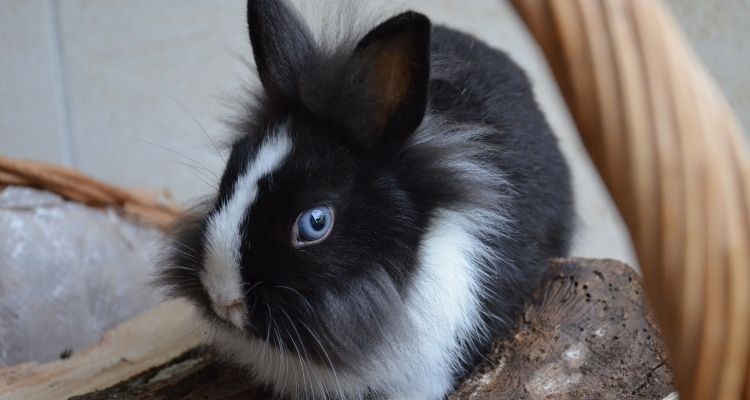
Checking your rabbit’s eyes (both the eyeball and rim of the eye) for any redness or discharge is an important part of grooming.
Sometimes, rabbits can get poked in the eye from hay, causing irritation. Whilst this is more common in small animals such as guinea pigs, it can occur in rabbits also. It is known as “hay poke”.
A useful home remedy for hay poke is a couple of drops of colloidal silver liquid (purchase on Amazon here) in the affected eye for 2-3 days. If the eye hasn’t started to heal after this time, seek veterinary advice.
If your rabbit has heavy fur around its eyes, you may want regularly comb back the hair away from the eye, or trim any hair that falls near the eyes to avoid any irritation.
Fleas, Ear Mites & Parasites
Fleas, mites and ticks impact your rabbit’s health and may cause significant damage to their skin.
Here’s what to look for:
- Black Fleas – Common around the face, top of head and ears and genitals.
- Mites – Look like dandruff in the fur and on the skin
- Ear Mites – Look for dark dried debris left behind from the mites in the ears of your rabbit. (Try Eradimite Solution available here)
- Ticks – Oval shaped and crawling anywhere on your rabbit, or attached to the skin.
Even when rabbits are housed indoors, they may be susceptible to fleas, ticks and mites. This can be from other animals that bring them in from outdoors, feed such as hay, or accidently brought in on our clothing or shoes.
Advantage and Revolution are two topical medications you can give to your rabbit to prevent flea infestations. You can pick up Advantage II on Amazon.
Eradimite Solution is suitable to use on rabbits and works well for ear mites. It is available on Amazon here.
IMPORTANT: Frontline Flea and Tick Medication is contraindicated for rabbits. It has been linked to death in rabbits at worst, and neurological damage in rabbits that survive. Read the label carefully before purchasing any free and tick medication to ensure it is safe for rabbits. As mentioned above, Revolution and Advantage can be used.
Rabbit Scent Gland Cleaning
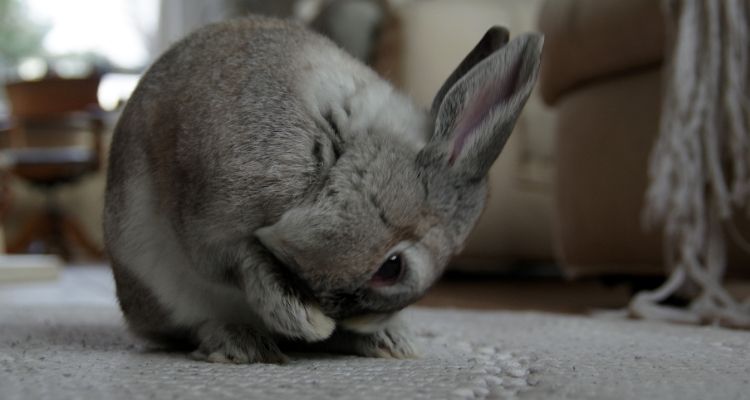
Rabbits have scent glands both under their chin and in their genital area.
It is important to regularly check the scent glands surrounding the anus of your rabbit.
When these scent glands build up, the rabbit may emit an unpleasant odor. This is generally caused by a blocked duct. The waxy looking build up may become hard and uncomfortable for your bunny.
The good news is you can easily help the rabbit to clean this duct by using mineral oil and a q-tip or cotton ball. Here’s how:
Items Needed:
- Q-Tip or Cotton Balls
- Mineral Oil (link to purchase here)
Steps to Clean the Anal Scent Glands:
- Coat a q-tip or cotton ball generously with mineral oil and place on a piece of plastic, or foil (something waterproof) ready to use.
- Hold your rabbit in a safe position so you can access the genitals. Important – Don’t lay your rabbit on its back. This can lead to trancing, which is stressful for your rabbit and is a potential danger.
- There will be two slits – one on each side of the rabbit’s genitals.
- Take the q-tip or cotton ball and gently wipe it over the slits to moisten the area.
- Wait a minute or two for the mineral oil to penetrate and wipe again to clean this area. It could take a few wipes to clean the scent glands.
NB: Like humans, this is a delicate area. Work quickly but gently to avoid stressing or causing damage to your rabbit.
Whilst you have the rabbit in this position, check the underside of him. Look for excess urine staining or droppings. Ensure you frequently change the rabbit litter for ultimate cleanliness.
Checking Your Rabbits Feet
Checking both the bottom and top of your rabbits feet (called their hocks) is also an essential part of grooming. A rabbit needs the fur padding on their feet to prevent injury.
Look for any matted fur on around your rabbits feet and gently remove the matting.
Check for any wear on their foot pads, inflamed skin or calluses. Any exposed skin could become infected when the rabbit urinates (if the urine comes into contact with the skin).
Ensure you keep the litter box and any rabbit bedding clean and dry and provide your rabbit with extra soft resting pads or blankets whilst their hocks are healing.
Conclusion
Grooming your rabbit will provide you with wonderful time together. It is an opportunity to connect and bond with your rabbit. It should not be unpleasant or difficult for you or your beautiful bunny.
Many rabbits enjoy the grooming session with their humans, so take the time to care for your bunny. He or she will thank you.

